Google Nexus 4 Review - Google's new Flagship
by Brian Klug on November 13, 2012 8:45 AM EST- Posted in
- Smartphones
- LG
- Android
- Mobile
- APQ8064
- Nexus 4
- Android 4.2
- MDM9215
Battery life in the Nexus 4 is a big concern for many, especially since the Nexus 4 isn’t designed to have a user replaceable battery. What’s inside is a 2100 mAh 3.8V battery which is 8.0 watt-hours. I had been wondering for a while what the chemical compound used in the 3.8V battery cells we’re seeing emerge was, and finally got a tad more info at least about the LG Chem approach. This is the higher voltage chemistry from LG Chem which is Lithium Cobalt Oxide (LiCoO2) based and includes electrolyte additives to prevent gas generation in the cell which affects lifetime during high temperature periods. Although getting the back off of the Nexus 4 is relatively easy and requires just removing two Torx 4 screws and prying up on the plastic, I doubt anyone is going to make a back to accommodate an extended battery due to the presence of 4 antennas which are integrated into the back cover.
The Nexus 4 incorporates wireless charging into that back alongside NFC. For wireless charging the Nexus 4 uses a TI BQ51051b wireless power Li-Ion charger receiver. I’ve been pretty remiss in looking into wireless charging and actually trying it myself, so I went ahead and bought a two-position Energizer Qi compliant charging mat.
The Nexus 4 is Qi 1.1 wireless charging forum compliant, so any charger that is Qi compliant or includes the logo will charge it. Aligning the Nexus 4 on the Energizer mat is a bit tricky since the surface is slick and angled down, and the back of the Nexus 4 is primarily glass, but it isn’t difficult after you know where to align. The Nexus 4 charges from fully discharged to completely charged in 3.033 hours on the Qi mat, which is basically the same charge time as I saw off of microUSB on a BC 1.2 charger.
In Android you’ll see Charging (Wireless) when this mode is employed. I used the Palm Pre touchstone charger a lot back in the day and saw that get pretty hot during a charge cycle. The Nexus 4 doesn’t get nearly as warm. I’ve noticed that at the top of the charge cycle you’ll see the Nexus 4 selectively draw power from the charging dock since there doesn’t seem to be an equivalent trickle charge mode or something, but this is normal.
Battery Life
I’ve had the chance to run more battery life tests on the Nexus 4, and run the cellular test a few more times. The results are quite consistent and we don’t see that result change very much at all. I’ve also added the call time test and tethering results.
We regularly load web pages at a fixed interval until the battery dies (all displays are calibrated to 200 nits as always). The differences between this test and our previous ones boil down to the amount of network activity and CPU load.
On the network side, we’ve done a lot more to prevent aggressive browser caching of our web pages. Some caching is important otherwise you end up with a baseband test, but it’s clear what we had previously wasn’t working. I’ve made sure that despite the increased network load, the baseband still has the opportunity to enter its idle state during the course of the benchmark, we’re not destroying the RRC states with too aggressive of a load time.
We also increased CPU workload along two vectors: we decreased pause time between web page loads and we shifted to full desktop web pages, some of which are very JS heavy. The end result is a CPU usage profile that mimics constant, heavy usage beyond just web browsing. Everything you do on your smartphone ends up causing CPU usage peaks - opening applications, navigating around the OS and of course using apps themselves. Our 5th generation web browsing battery life test should map well to more types of smartphone usage, not just idle content consumption of data from web pages.
As always we test across multiple air interfaces (3G, 4G LTE, WiFi), but due to the increased network load we actually find that on a given process technology we see an increase in battery life on faster network connections. The why is quite simple to understand: the faster a page is able to fully render, the quicker all components can drive down to their idle power states. All Android tests use Chrome and 5GHz WiFi unless otherwise listed.
The tethering test still consists of four tabs of the webpage tests in conjunction with a 128 kbps streaming MP3 radio station over the smartphone’s personal WiFi hotspot.
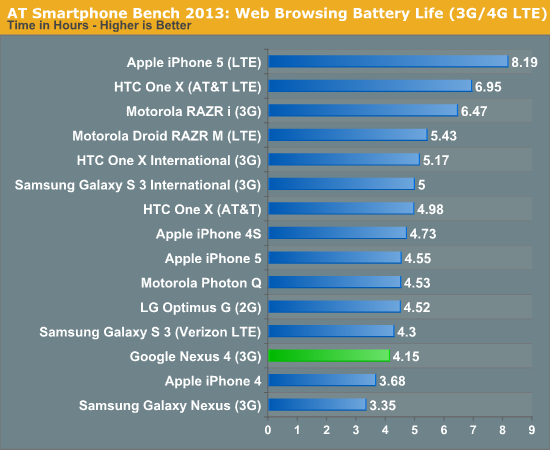
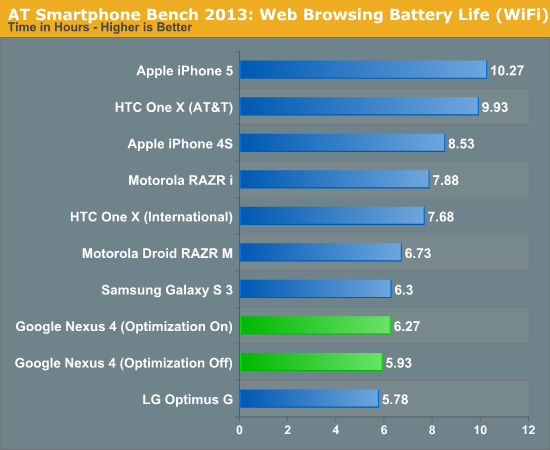
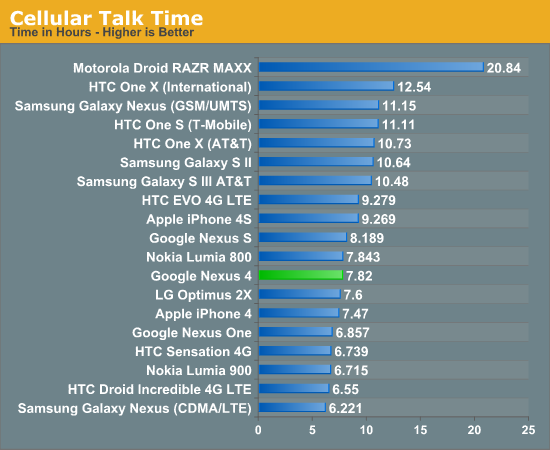
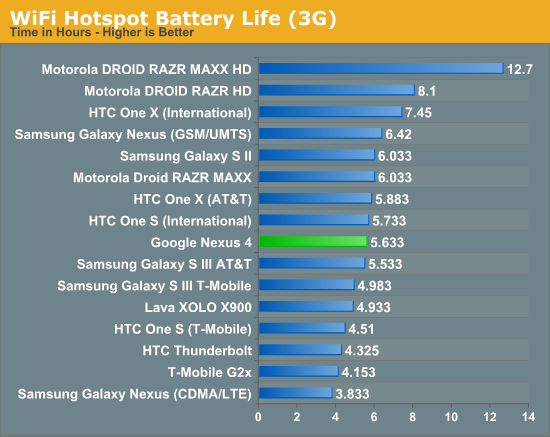
I've run and re-run the battery life tests on the Nexus 4 and they haven't changed since our preview a whole bunch. The result is battery life that isn't really chart topping, yet in my time with the Nexus 4 I haven't really been want for more battery life at any point. I'm able to get through a single day with the device set on auto brightness.



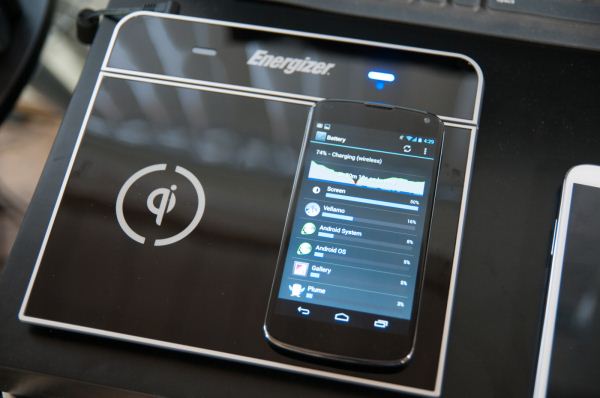

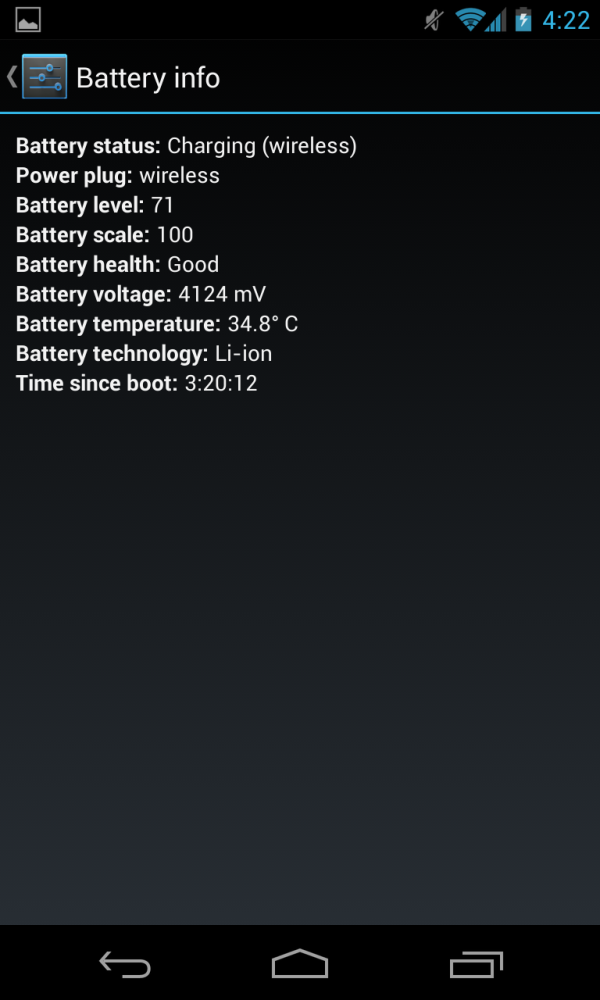








188 Comments
View All Comments
Impulses - Tuesday, November 13, 2012 - link
There's an app a ton of people are using with the N7 sans root that allows them to import or even stream video from USB devices using OTG, it's a pretty solid workaround for those that would rather avoid rooting.thesavvymage - Wednesday, November 14, 2012 - link
know what this app is called by any chance? I havent heard of any way for them to read off a usb without rootingFreedomuser - Wednesday, November 14, 2012 - link
The none-root app called Nexus Media Importer. There is a thread in accessories in xda for DIY USB OTG to microSD is great. Check it out.andybryant - Wednesday, November 14, 2012 - link
I guess this is the threadhttp://forum.xda-developers.com/showthread.php?t=1...
Sounds like an opportunity for a kickstarter.
https://play.google.com/store/apps/details?id=com....
twtech - Tuesday, November 13, 2012 - link
I would be tempted to try this phone, except for the battery life. That could probably be mitigated somewhat by buying a few charging mats, but still I don't think I could ever go back from having all-day no hassle battery life to having to watch the battery meter again to make sure that my phone isn't going to turn off.Also, the glass back sounds a bit dangerous, but it's a relief to hear you dropped it a few times with no ill-effects.
Rits - Tuesday, November 13, 2012 - link
Brian, let me thank you for this fantastic review. Its probably going to be the definitive review of the Nexus 4. The level of detail just made me smile! And thanks for the audio fidelity part (graph missing?) and teaming up with François was just what I needed. I'll await his (or your) detailed analysis of that part.Keep up the great work. :)
wffurr - Tuesday, November 13, 2012 - link
What an incredibly thorough review. This is the first Anandtech smartphone review I have read, and I am seriously impressed. Thank you for all your hard work.One thing that I would like to see included is the brightness, black level, and contrast measurements for the Galaxy Nexus. Are they not included because it's an AMOLED display?
That's my current phone, and I also think it's instructive to see the improvement in the Nexus line against its direct predecessor.
MadMan007 - Tuesday, November 13, 2012 - link
Out of those, brightness is the only thing you can meaningfully measure for AMOLED. Black is 0 and contrast is therefore 'infinite.' Note that the Galaxy Nexus is listed on the brightness chart.Guspaz - Tuesday, November 13, 2012 - link
I'm confused. The phone seems to have horrible performance, making it one of the slowest Android phones in the benchmarks (doesn't matter to users why the browser benchmarks are so bad, only that they are) and terrible overheating problem, but it's "the phone to get?"It sounds more like a critically flawed product that should be avoided at all costs. There are plenty of other Android phones that don't have performance or overheating problems.
uhuznaa - Tuesday, November 13, 2012 - link
It's really cheap, though. Don't underestimate the draw of being able to afford it without much thinking. Worked great with the Nexus 7 too.Personally I'm really pissed off by the battery life despite a huge battery, this thing is quite a brick.